
http://www.iaeme.com/IJM/index.as 237 editor@iaeme.com
International Journal of Management (IJM)
Volume 8, Issue 2, March– April 2017, pp.237–245, Article ID: IJM_08_02_026
Available online at
http://www.iaeme.com/ijm/issues.asp?JType=IJM&VType=8&IType=2
Journal Impact Factor (2016): 8.1920 (Calculated by GISI) www.jifactor.com
ISSN Print: 0976-6502 and ISSN Online: 0976-6510
© IAEME Publication
SIGNIFICANCE OF COST EFFECTIVENESS
ANALYSIS AND COST BENEFIT ANALYSIS IN
INFRASTRUCTURE DEVELOPMENT
COMPANY
Dr. J.S.V. Gopala Sarma
Professor & HOD, Department of MBA
Institute of Aeronautical Engineering, Dundigal, Hyderabad, India
ABSTRACT
Most often cost-effectiveness and cost-benefit studies are conducted at a level that
involves more than just a local program (such as an individual State Strengthening
project). Sometimes they also involve following up over a long period of time, to look at
the long-term impact of interventions. They are often used by policy analysts and
legislators to make broad policy decisions, so they might look at a large federal
program, or compare several smaller pilot programs that take different approaches to
solving the same social problem. People often use the terms interchangeably, but there
are important differences between them. Cost - Effectiveness analysis assumes that a
certain benefit or outcome is desired, and that there are several alternative ways to
achieve it. The basic question asked is,
"Which of these alternatives is the cheapest or most
efficient way to get this benefit?"
By definition, cost-effectiveness analysis is comparative,
while cost-benefit analysis usually considers only one program at a time. Another
important difference is that while cost-benefit analysis always compares the monetary
costs and benefits of a program, cost-effectiveness studies often compare programs on
the basis of some other common scale for measuring outcomes (eg., number of students
who graduate from high school, infant mortality rate, test scores that meet a certain
level, reports of child abuse). The Cost-Benefit Analysis denotes a methodology for a
project evaluation and also a fundamental concept on economic matters. In this respect,
the present article reviews some plain concepts which, if misjudged, may lead to assign
an economic meaning to usual results having a strictly financial scope. Lying on this
premise, the conclusion focuses on the needing for broader categories to evaluate the
economic cost-benefit relationships of an investment project. The analysis of the
Benefits and Costs of a project aims to evaluate the economic rationality of a possible
investment decision. Regarding this, a review on the meaning of that singular
methodology known as the “cost-benefit analysis”, CBA, here is proposed based on the
premise that it focuses on a narrow definition of the economic matter. The CBA provides
an accurate conceptual ground to assess business decisions in a market economy, where
the production initiatives are assumed at their entrepreneurs’ risk. That foundation goes

Significance of Cost Effectiveness Analysis and Cost Benefit Analysis In Infrastructure
Development Company
http://www.iaeme.com/IJM/index.as 238 editor@iaeme.com
beyond the particular way in which the analysis is performed, pursuing to know whether
it can be expected an investment will have a value higher than its cost. Would the latter
situation hold, the difference between both amounts will be granted as an extraordinary
retribution to the entrepreneurial initiative? On this subject, a simple model explains
how that differential of values comes into evidence when the financial principles of
valuation get differentiated from those economic outcomes submitted to evaluation.
Conversely, the extension of the above mentioned principle to the field of wider
economic and environmental evaluations does not seem to have the same accurate
meaning, because it pays attention only to a partial matter. What argued is the need to
enlarge the categories and approach of the analysis when evaluating, for the society as
a whole, the economic performance of a project and the economic consequences derived
from environmental matters (and in any other case where to deal with the long run was
required). In item I the CBA methodology will be described by means of a formal
analysis, to settle an interpretation over its meaning and scope. Next, in item II, the
answer previously obtained will be analyzed in terms of its adequacy for a private
business under the context of a monetary economy. The third item will describe those
restrictions observed on the CBA applicability for business and on its economic
meaning either for society or for an environmental issue. Finally, item IV proposes some
reflection lines to address an analysis regarding the economic evaluation of an
investment project. This paper reveals cost allocation, cost effectiveness analysis, cost
benefit analysis, theoretical view of Cost Effectiveness Analysis and cost Benefit
Analysis.
Key words: Cost Allocation, Cost Effectiveness analysis, Cost Benefit Analysis,
Theoretical view of Cost Effectiveness Analysis and cost Benefit Analysis.
Cite this Article: Dr. J.S.V.Gopala Sarma, Significance of Cost Effectiveness Analysis
and Cost Benefit Analysis In Infrastructure Development Company. International
Journal of Management, 8(2), 2017, pp. 237–245.
http://www.iaeme.com/IJM/issues.asp?JType=IJM&VType=8&IType=2
INTRODUCTION
Cost analysis
(also called
economic evaluation, cost allocation, efficiency assessment, cost-benefit
analysis,
or
cost-effectiveness analysis
by different authors) is currently a somewhat controversial
set of methods in program evaluation. One reason for the controversy is that these terms cover
a wide range of methods, but are often used interchangeably. At the most basic level,
cost
allocation
is simply part of good program budgeting and accounting practices, which allow
managers to determine the true cost of providing a given unit of service (Kettner, Moroney, &
Martin, 1990). At the most ambitious level, well-publicized
cost-benefit
studies of early
intervention programs have claimed to show substantial long-term social gains for participants
and cost savings for the public (Berreuta-Clement, Schweinhart, Barnett, et al., 1984). Because
these studies have been widely cited and credited with convincing legislators to increase their
support for early childhood programs, some practitioners advocate making more use of cost-
benefit analysis in evaluating social programs (Barnett, 1988, 1993). Others have cautioned that
good cost-benefit or cost-effectiveness studies are complex, require very sophisticated technical
skills and training in methodology and in principles of economics, and should not be undertaken
lightly (White, 1988). Whatever position you take in this controversy, it is a good idea for
program evaluators to have some understanding of the concepts involved, because the cost and
effort involved in producing change is a concern in most impact evaluations (Rossi & Freeman,
1993).

Dr. J.S.V.Gopala Sarma
http://www.iaeme.com/IJM/index.as 239 editor@iaeme.com
CLASSIFICATION OF COST ANALYSIS
Cost analysis may
be
classified into three categories in evaluation. They are
• Cost Allocation
• Cost - Effectiveness analysis
• Cost - Benefit analysis
1. COST ALLOCATION
Cost allocation is a simpler concept than either cost-benefit analysis or cost-effectiveness
analysis. At the program or agency level, it basically means setting up budgeting and accounting
systems in a way that allows program managers to determine a
unit cost
or
cost per unit of
service
. This information is primarily a management tool. However, if the units measured are
also outcomes of interest to evaluators, cost allocation provides some of the basic information
needed to conduct more ambitious cost analyses such as cost-benefit analysis or cost-
effectiveness analysis. For example, for evaluation purposes, you might want to know the
average cost per child of providing an after-school tutoring program, including the costs of staff
salaries, snacks, and other overhead costs. Besides budget information, being able to determine
unit costs means that you need to be collecting the right kind of information about clients and
outcomes. In many agencies, the information recorded in service records is based on reporting
requirements, which are not always in a form that is useful for evaluation.
2. COST - EFFECTIVENESS ANALYSIS
Most often, cost-effectiveness and cost-benefit studies are conducted at a level that involves
more than just a local program (such as an individual State Strengthening project). Sometimes
they also involve following up over a long period of time, to look at the long-term impact of
interventions. They are often used by policy analysts and legislators to make broad policy
decisions, so they might look at a large federal program, or compare several smaller pilot
programs that take different approaches to solving the same social problem. People often use
the terms interchangeably, but there are important differences between them.
Cost -
Effectiveness analysis assumes that a certain benefit or outcome is desired, and that there are
several alternative ways to achieve it. The basic question asked is, "Which of these
alternatives is the cheapest or most efficient way to get this benefit?" By definition, cost-
effectiveness analysis is comparative, while cost-benefit analysis usually considers only one
program at a time. Another important difference is that while cost-benefit analysis always
compares the monetary costs and benefits of a program, cost-effectiveness studies often
compare programs on the basis of some other common scale for measuring outcomes (eg.,
number of students who graduate from high school, infant mortality rate, test scores that meet
a certain level, reports of child abuse). They address whether the unit cost is greater for one
program or approach than another, which is often much easier to do, and more informative,
than assigning and
how to budget & allocate costs for cost effectiveness studies:
The type of budgeting and accounting system your program or agency uses may well
determine how much useful cost data is available for evaluating your program, or comparing it
to others. Three major types of budgeting formats commonly used in social service programs
will provide different types and amounts of information (Kettner, Moroney, & Martin, 1990).
The most common format is the
Line-Item Budget
format, which simply looks at revenues
(money coming in from various sources, including grants, user fees or United Way funds) and
expenditures (costs broken down into broad categories like salaries, rent, utilities, and postage),
and tries to ensure that they balance. The main purpose of a line-item budget is financial control,
and the categories are usually too broad to give much information about the cost of providing

Significance of Cost Effectiveness Analysis and Cost Benefit Analysis In Infrastructure
Development Company
http://www.iaeme.com/IJM/index.as 240 editor@iaeme.com
a particular service or obtaining a particular result. The
Functional Budget
format starts with a
line-item budget, and takes it a step further. It focuses on process, or the cost of providing a
service. For example, with a Functional Budget, we could determine that it cost an adoption
agency $45,000 to conduct 100 home studies (an activity which is a necessary part of the
process of placing children in permanent homes). The
Program Budget
, which also starts with
a line-item budget, looks at the same information from the point of view of outcomes, or the
cost of achieving a result. For example, if the 100 home studies resulted in actually placing 50
children in adoptive homes, the Program Budget would allow us to say that it cost the agency
$45,000 to place 50 children, which is an outcome. Another way to look at this is that functional
budgets measure productivity and program budgets measure the cost of achieving goals and
objectives.
3. COST - BENEFIT ANALYSIS
The basic questions asked in a cost-benefit analysis are,
"Do the economic benefits of providing
this service outweigh the economic costs"
and
"Is it worth doing at all"?
One important tool of
cost-benefit analysis is the
benefit-to-costs ratio
, which is the total monetary cost of the benefits
or outcomes divided by the total monetary costs of obtaining them. Another tool for comparison
in cost-benefit analysis is the
net rate of return
, which is basically total costs minus the total
value of benefits. The idea behind cost-benefit analysis is simple: if all inputs and outcomes of
a proposed alternative can be reduced to a common unit of impact (namely dollars), they can
be aggregated and compared. If people would be willing to pay dollars to have something,
presumably it is a benefit; if they would pay to avoid it, it is a cost. In practice, however,
assigning monetary values to inputs and outcomes in social programs is rarely so simple, and it
is not always appropriate to do so (Weimer & Vining, 1992; Thompson, 1982; Zeckhauser,
1975).
An example will illustrate some of the differences between Cost-Effectiveness and Cost-
Benefit studies, what they can tell you, and some of the issues that neither can effectively address:
"Suppose the drop-out rate in an inner-city high school is 50%. Prevention Program A
enrolls 20 students, costs $20,000, and 15 of the 20 students (75%) graduate. Thus Program A
resulted in 5 additional graduates at a cost of $20,000, or one additional graduate for every
$4,000. Prevention Program B enrolls 20 students, costs $15,000, and 12 of the 20 students
(60%) graduate. Thus Program B resulted in 2 additional graduates at a cost of $15,000, or one
additional graduate for every $7,500 spent. Although Program B is cheaper ($15,000 compared
to $20,000), Program A is more
Cost effective
($4,000/each additional graduate, compared to
$7,500/additional graduate). A
cost-benefit analysis
in this situation, instead of comparing unit
costs, would require estimating the dollar value of high school graduation (for example, by
projecting the difference in lifetime earning capacity of graduates over drop-outs, and lifetime
social service costs), and comparing the monetary value of producing more graduates to the
monetary cost of providing the program in the first place.
Neither method effectively addresses
more intangible outcomes of graduation, such as increased self-esteem, or the value of a peer
support system.
" (White, 1988, p. 430)
4. HOW TO CONDUCT A COST - BENEFIT ANALYSIS
Cost-benefit analysis is by far the most complex and controversial of the three methods of costs
analysis we have discussed. It should not be attempted by those who lack technical expertise in
this area. However, for some purposes, it is also one of the most powerful methods. For those
who decide to undertake a cost-benefit analysis in spite of the difficulties, Barnett (1993)
outlines a nine step process. Various standard texts are recommended for more in-depth
information (see below).

Dr. J.S.V.Gopala Sarma
http://www.iaeme.com/IJM/index.as 241 editor@iaeme.com
• Step 1: Define the Scope or Perspective of the Analysis - The first step is to describe the
alternative(s) to be evaluated, and determine whose perspective will guide the evaluation. A
narrow cost analysis might look only at the monetary costs and benefits to the individual
participant or target of services, or to a particular funder or agency. A broader perspective might
attempt to look at a wide range of costs and consequences (intended and unintended, direct and
indirect) for society as a whole. A program that is not cost-effective from the perspective of a
particular agency within its limited mission and budget may well be cost-effective from the
perspective of society, because it saves expenses or prevents problems in other areas. Rossi and
Freeman (1993) note that because different stakeholders may have different values and a
priority, mixing different viewpoints is likely to result in "confused specifications and
overlapping or double counting." Whether we like it or not, the perspective chosen for cost
evaluation may have political implications. Therefore, while there are limitations to any one
perspective, it is important for the evaluator to clearly state his or her position.
• Step 2: Conduct Cost Analysis - The next step is to identify and estimate the monetary value
of all resources used in the intervention, not just the budgetary costs. Some costs, such as salaries
of direct service staff, rental of office space, or program supplies, are obvious and simple to
determine.
• Step 3: Estimate Program Effects - This is where more traditional impact or outcome
evaluation methods come in. As noted earlier, if we don't know that there is a significant
beneficial effect of our program, there is little point in asking how much it costs to get the effect,
or whether it is more cost-effective than another kind of program. Many texts on evaluation can
assist you in designing a valid evaluation (Rossi & Freeman, 1993; State Strengthening
Evaluation Guide, 1997). Often it is not possible to use a true experimental design in evaluating
community-based programs, but there are a number of quasi-experimental designs available.
Also, don't forget that it is often possible to use existing data to estimate program effects, as
well. If you are looking at an ongoing program, or one that is based on a national model (such
as the Parents As Teachers program), check to see if formal evaluations have already been done
elsewhere. You may also be able to get useful information from the program's service statistics,
or from local, state, or federal census data.
• Step 4: Estimate the Monetary Value of Outcomes - This is one of the most difficult and
controversial aspects of conducting a cost-benefit analysis, and it may require the help of
consultants. Some cost-savings are easier to estimate than others. For example, we may have
data that the average cost of placing a child in residential treatment is $20,000 a year, so if we
are able to prevent 20 children from being placed in residential treatment, the estimated savings
is 20 X $20,000. However, other important outcomes may be much less obvious, and much
harder to estimate.
• Step 5: Account for the Effects of Time - One of the trickiest and most technical aspects of
cost-benefit analysis, especially for longitudinal studies that follow clients or outcomes over a
period of years, is discounting of costs and calculating rates of return for alternative uses of
the money (such as investing it). This includes taking into account the effects of inflation on the
value of the dollar over time, or figuring the depreciation in the value of things like buildings
and other capital equipment. Similar issues apply in estimating the value of benefits over a
period of time. For example, if we want to look at the projected life-time earnings of a teenager
who stays in school due to a drop-out prevention program compared to one who does not, we
need to make projections about wages. If we want to look at whether the government will
eventually recover its investment in the drop-out program through the taxes he or she will pay
on the increased income, we need to make projections about future tax rates as well. These
projections all require assumptions. Unless you or someone on the program staff has expertise
in this area, it is strongly advised that you seek out a skilled consultant to help with this step.
• Step 6: Aggregate and Apply a Decision Rule - If you are looking at the costs and benefits on
several outcomes (which is often the case), how will you decide which has priority? If a program
for pregnant teenagers results in healthier babies (and lower hospital costs), but not in fewer
repeat pregnancies, which outcome is more important?


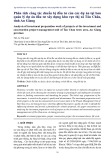
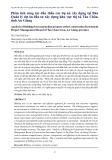
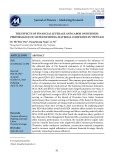



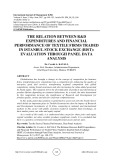
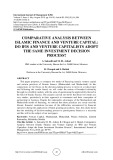
![Thuyết minh Dự án đầu tư Nhà máy sản xuất bột cá [Mới nhất]](https://cdn.tailieu.vn/images/document/thumbnail/2018/20180531/lapduandautu/135x160/2037095_2211.jpg)















